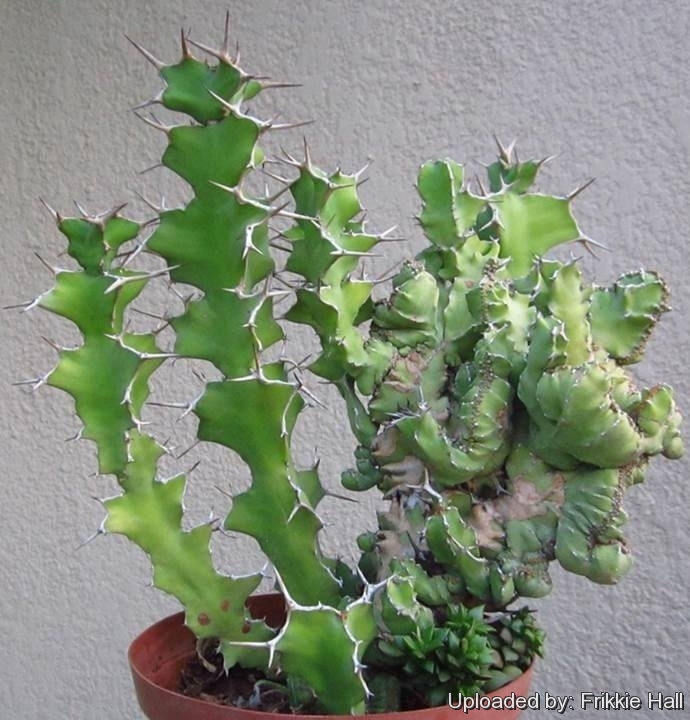Accepted Scientific Name: Euphorbia grandicornis K.I.Goebel ex N.E.Br.
Hooker's Icon. Pl. 26: t. 2531 1897.

Euphorbia grandicornis f. cristata Photo by: Frikkie Hall
Euphorbia grandicornis with crest.
Origin and Habitat: The original natural habitat of this species is KwaZulu-Natal, Swaziland, Mozambique, Kenya.
Synonyms:
See all synonyms of Euphorbia grandicornis
Description: The typical Euphorbia grandicornis is a shrubby columnar, cactus-like, euphorbia with strong spines resembling the shape of cows’ horns.
Crested form: The crested forms are cultivated for their beautiful stem with pronounced sculpture effects. These plants produce monstrous crests, and crests occasionally produce normal shoots. The odd crested forms are rare and may appear both on seedling batches in a very small percentage and in habitat too.
Subspecies, varieties, forms and cultivars of plants belonging to the Euphorbia grandicornis group
Cultivation and Propagation: It is an easy species to grow that is suited for any well drained soil in full sun. But young plant are happy growing indoors, where they can easily reach the ceiling. Give the plant an airy growing medium which mainly consists of non organic material such us clay, pumice, lava grit, and only a little peat or leaf-mould. Water regularly during the active growing season from March to September. No water should ever be allowed to stand around the roots. Keep almost completely dry in winter. It is a moderately fast grower, and will quickly become large landscape masterpieces in just 3-5 years. Only downside is from strong winds, the columns often smash into each other, causing permanent scarring... best to plant in such a location where winds are not a big issue. If plant becomes very red, this is a sign that the roots have not developed properly. It is a relatively fast growing and long lived plant and once established, it will be content in its position and with its soil for years. It can tolerate moderate shade, and a plant that has been growing in shade should be slowly hardened off before placing it in full sun as the plant will be severely scorched if moved too suddenly from shade into sun. Like quite small pots, repott in very later winter, early spring. Can be pruned for shape and branching. Frost tender, frost free zones only.
Crested growth: Unlike 'monstrous' varieties of plants, where the variation from normal growth is due to genetic mutation, crested growth can occur on normal plants. Sometimes it's due to variances in light intensity, or damage, but generally the causes are unknown. A crested plant may have some areas growing normally, and a cresting plant that looks like a brain, may revert to normal growth for no apparent reason. If you have any of the crested part left you need to remove the normal growth and leave the crested part behind this will need to be done regularly.
Plant Pests:* Prone to mealy bugs and rarely scale.
Propagation: It is easy to propagate by cuttings in late spring to summer, just take a cutting of the plant let it dry for 1 or 2 weeks and stuff it in the ground (preferably dry, loose, extremely well draining soil).
Warning: All Euphorbias contain a white sap that can be irritating to eyes and mucous membranes. If contact is made with this white sap, take care to not touch face or eyes before washing hands with soap and water.











